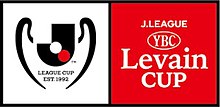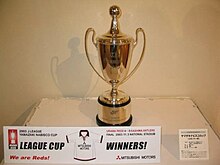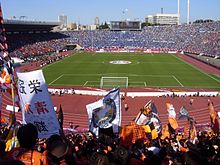J.League Cup
This article needs additional citations for verification. (March 2017) |
 | |
| Founded | 1992 |
|---|---|
| Region | Japan |
| Number of teams | 60 |
| Current champions | Nagoya Grampus (2nd title) |
| Most successful club(s) | Kashima Antlers (6 titles) |
| Television broadcasters | Fuji TV, SKY PerfecTV! (live matches) |
| Website | jleague.jp/cup |
The J.League Cup (Japanese: Jリーグカップ, Hepburn: Jē-rīgu Kappu) is a Japanese football (soccer) competition organised by J.League, the men's association football league in Japan. It has been sponsored by Yamazaki Biscuits (YBC) of Yamazaki Baking (formerly Yamazaki Nabisco) since its inception in 1992. It is a.k.a. J.League YBC Levain Cup (Japanese: JリーグYBCルヴァンカップ, Hepburn: Jē-rīgu Waibīshī Ruvan Kappu) or YBC Levain Cup (Japanese: ルヴァンカップ、ルヴァン杯, Hepburn: Ruvan Kappu) (Levain is one of YBC's products).[1] It was a.k.a. J.League Yamazaki Nabisco Cup (Japanese: Jリーグヤマザキナビスコカップ, Hepburn: Jē-rīgu Yamazaki Nabisuko Kappu) or Nabisco Cup (Japanese: ナビスコカップ、ナビスコ杯, Hepburn: Nabisuko Kappu) until August 2016.
It is generally regarded as the Japanese equivalent to league cup competitions played in many countries, such as the Football League Cup in England, as complementary to the Emperor's Cup competed between clubs from all divisions of professional football in Japan. Before the J. League Cup was created, the old Japan Soccer League had its own Japan Soccer League Cup since the 1976 season.
The tournament format varies almost each year largely depending on the schedule of international matches such as the Olympic Games and World Cup games (see the Format section below).
From 2007 to 2023, the winners qualified for the J.League Cup / Copa Sudamericana Championship held in the following summer, where they played against the winners of the Copa Sudamericana. The tournament was cancelled in 2020 due to the COVID-19 Pandemic, but was not held for 2021 and 2022, before ultimately being cancelled in 2023.
Format
[edit]Early years (1992–1998)
[edit]- 1992
- The founding ten clubs of the J. League participated as a warm-up to the upcoming inaugural league season. At the group stage, each team played the other teams once. There was no draw and the golden goal, extra time and penalty shootout was employed to decide a tie if necessary. A sudden death was applied to the penalty shoot-out from the first kicker. The winner of a game got four points. A team who scored two or more goals in a game also won one point. The top four teams of the group stage went on to the knock-out stage where the ties were single matches.
- 1993
- Thirteen teams (the ten J. League sides as well as the three JFL sides who had J. League associate membership) took part. At the group stage, the teams were divided into two groups, one consisting seven and the other consisting six. Each team played the other teams in the same group once. The top two teams of each group were qualified for the knock-out stage where the ties were single matches.
- 1994
- Fourteen teams (the twelve J. League sides as well as the two JFL sides who had J. League associate membership) took part. There was no group stage. The ties were single matches all through the competition.
- 1995
- No competition
- 1996
- The sixteen J. League sides participated. J. League associate member teams did not take part due to the congested schedule. At the group stage, the teams were divided into two groups. Each team played the other teams in the same group twice (home and away). A tie was decided by the aggregate of two matches. The winner of a tie got three points and a draw earned one point. The top two teams of each group were qualified for the knock-out stage where the ties were single matches.
- 1997
- Twenty teams (all the J. League clubs and the JFL clubs with J. League associate membership) participated. At the group stage, the teams were divided into five groups. Each team played the other teams in the same group once. A win earned three points, a draw earned one point. There was no extra time at this stage. The top team of each group, as well as the three second-placed teams with the best records, were qualified for the knock-out stage where the ties were played over two matches (home and away). Although Sagan Tosu had forfeited their associate membership because of the bankruptcy of their forerunner Tosu Futures, they were allowed to enter the competition as a special case.
- 1998
- Twenty teams (all the J. League clubs and the JFL clubs with J. League associate membership) participated. At the group stage, the teams were divided into four groups. Each team played the other teams in the same group once. The top team of each group was qualified for the knock-out stage where the ties were single matches.
As tournaments for J1 and J2 (1999–2001)
[edit]- 1999
- All the twenty-six J1 and J2 clubs participated. There was no group stage. The ties were played over two matches (home and away) except the final where the winners were decided by a single game.
- 2000
- All the twenty-seven J1 and J2 clubs participated. There was no group stage. The ties were played over two matches (home and away) except the final where the winners were decided by a single game.
- 2001
- All the twenty-eight J1 and J2 clubs participated. There was no group stage. The ties were played over two matches (home and away) except the final where the winners were decided by a single game.
As tournaments for only J1 (2002–2017)
[edit]- 2002
- All the sixteen J1 teams took part. At the group stage, the teams were divided into four groups. Each team played the other teams in the same group twice. The top two teams of the each group were qualified for the knock-out stage where the ties were single matches.
- 2003

- All the sixteen J1 teams took part. Kashima Antlers and Shimizu S-Pulse were exempted from the group stage because they participated in the AFC Champions League. The remaining fourteen teams were divided into four groups, two groups containing four teams and the other two groups containing three. The top team of the each group and the second placed teams of the groups containing four teams as well as Kashima and Shimizu were qualified for the knock-out stage. The ties were played over two matches (home and away) except the final where the winners were decided by a single game.
- 2004
- All the sixteen J1 teams took part. At the group stage, the teams were divided into four groups. Each team played the other teams in the same group twice. The top two teams of the each group were qualified for the knock-out stage where the ties were single matches.
- 2005
- All the eighteen J1 teams took part. Yokohama F. Marinos and Jubilo Iwata were exempted from the group stage because they participated in the AFC Champions League. The remaining sixteen teams were divided into four groups. Each team played the other teams in the same group twice. The top team of the each group and the two second-placed teams with the best records as well as Marinos and Iwata were qualified for the knock-out stage. The ties were played over two matches (home and away) except the final where the winners were decided by a single game. From this year's competition, the golden goal rule was abolished and the extra time was always played for thirty minutes.
- 2006
- All the eighteen J1 teams took part. Gamba Osaka were exempted from the group stage because they participated in the 2006 AFC Champions League. The remaining seventeen teams were divided into four groups, three of them containing four teams and the other containing five teams. Each team played the other teams in the same group twice but only one game was played between some pairs of teams in the group containing five teams. The top team of the each group and the three second placed teams with the best records as well as Gamba Osaka were qualified for the knock-out stage. The ties were played over two matches (home and away) except the final where the winners were decided by a single game. The away goal rule was employed for this year's competition but it was not applied to a goal in the extra time.
- 2007
- The format of the 2007 competition was similar to that of 2006's, but the number of clubs participating from the group stage has been decreased to 16 due to two clubs', Kawasaki Frontale and Urawa Red Diamonds, participation in the 2007 AFC Champions League. See 2007 J. League Cup for details.
- 2008

- The format of the 2008 competition was similar to that of 2007's. See 2008 J. League Cup for details.
- 2009
- The format of the 2009 group stage was changed due to the number of clubs participating 2009 AFC Champions League increased from two to four. 14 remaining clubs were divided into two groups with seven clubs each, then two top clubs of each group were qualified for the knock-out stage. See 2009 J. League Cup for more details.
- 2010
- The format of the 2010 competition was same as that of 2009's. See 2010 J. League Cup for details.
- 2011
- Although the format of the 2011 competition is planned to be same as that of 2009's and 2010's, it was abandoned due to 2011 Tōhoku earthquake and tsunami and replaced by a format without group stage (five knockout stages only). See 2011 J. League Cup for details.
- 2012–2017
- See 2012 J. League Cup, 2013 J. League Cup, 2014 J. League Cup, 2015 J. League Cup, 2016 J. League Cup, and 2017 J.League Cup for details.
As tournaments for J1 and J2 (2018–2023)
[edit]0 to 2 clubs (varies depending on the number of J1 teams participating in the ACL group stage) that were relegated to J2 last year and all J1 clubs can now participate. This is last season of group stage format in 2023.
As tournaments for J1, J2 and J3 (2024–present)
[edit]All of the 60 J. League clubs participated in a full knockout format which started from 2024.
For the 2024 season, the three Japanese clubs qualified for the 2023–24 AFC Champions League knockout stage (i.e. Kawasaki Frontale, Yokohama F. Marinos and Ventforet Kofu) received a bye to the knockout phase, while the remaining 57 J.League clubs were split into 10 groups of five or six for the first three rounds (known as the "first stage") based on their performance in the 2023 league season, with the winners of each single leg single-elimination group advanced to the two-legged play-off round. The five winners of the play-off round will join the three aforementioned clubs in the knockout stage (known locally as the "prime stage"), in which the format was unchanged.
Prizes
[edit]- Champions: J. League Cup, YBC Levain Cup, Champion medals and 150 million yen
- Runners-up: J. League Commemorative Plaque, Runner-up medals, and 50 million yen
- 3rd place (2 clubs): J. League Commemorative Plaque and 20 million yen to each 3rd placed club
Trophy
[edit]The trophy has been produced by Tiffany & Co. since the third tournament in 1994. The sterling silver trophy, about 56cm tall, includes a soccer ball motif at the tip as a design feature. The tournament names "J.LEAGUE" and "YBC Levain CUP" are engraved on a silver plate attached to its ebony wood base.[2]
Finals
[edit]Performances by team
[edit]| Club | Winners | Runners-up | Winning seasons | Runners-up seasons |
|---|---|---|---|---|
| Kashima Antlers | 6
|
3
|
1997, 2000, 2002, 2011, 2012, 2015 | 1999, 2003, 2006 |
| Tokyo Verdy | 3
|
1
|
1992, 1993, 1994 | 1996 |
| FC Tokyo | 3
|
0
|
2004, 2009, 2020 | |
| Urawa Red Diamonds | 2
|
5
|
2003, 2016 | 2002, 2004, 2011, 2013, 2023 |
| Júbilo Iwata | 2
|
3
|
1998, 2010 | 1994, 1997, 2001 |
| Gamba Osaka | 2
|
3
|
2007, 2014 | 2005, 2015, 2016 |
| JEF United Chiba | 2
|
1
|
2005, 2006 | 1998 |
| Kashiwa Reysol | 2
|
1
|
1999, 2013 | 2020 |
| Nagoya Grampus | 2
|
0
|
2021, 2024 | |
| Shimizu S-Pulse | 1
|
4
|
1996 | 1992, 1993, 2008, 2012 |
| Kawasaki Frontale | 1
|
4
|
2019 | 2000, 2007, 2009, 2017 |
| Cerezo Osaka | 1
|
2
|
2017 | 2021, 2022 |
| Sanfrecce Hiroshima | 1
|
2
|
2022 | 2010, 2014 |
| Yokohama F. Marinos | 1
|
1
|
2001 | 2018 |
| Oita Trinita | 1
|
0
|
2008 | |
| Shonan Bellmare | 1
|
0
|
2018 | |
| Avispa Fukuoka | 1
|
0
|
2023 | |
| Hokkaido Consadole Sapporo | 0
|
1
|
2019 | |
| Albirex Niigata | 0
|
1
|
2024 |
Most valuable players
[edit]New Hero Award
[edit]This award is presented to an under-23 player who made the biggest contribution to his team in the competition. The winner is decided based on votes from football journalists.
Broadcasters
[edit]Japan
[edit]All matches of the competition is currently broadcast live by Fuji TV and SKY PerfecTV! respectively.
Outside Japan
[edit]YouTube only broadcast live coverage in prime stage matches through J.League International channel (exc. China, Hong Kong, and Thailand).[3]
See also
[edit]References
[edit]- ^ "2016 J.League Cup renamed to J.League YBC Levain Cup". J. League. 22 June 2016. Archived from the original on 4 August 2017. Retrieved 4 September 2016.
- ^ "2024JリーグYBCルヴァンカップの優勝トロフィー【2024JリーグYBCルヴァンカップ】:Jリーグ公式サイト(J.LEAGUE.jp)". Jリーグ.jp(日本プロサッカーリーグ) (in Japanese). Retrieved 23 November 2024.
- ^ "2020 J.LEAGUE YBC Levain CUP Prime Stage to be broadcast overseas:en". J.League. Retrieved 2020-09-01.[permanent dead link]
